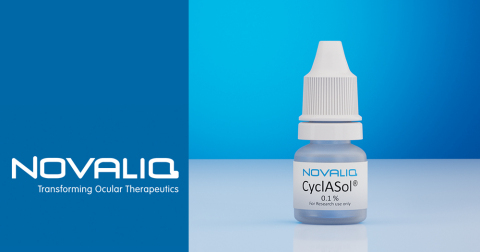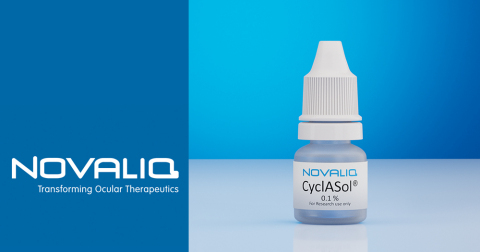HEIDELBERG, Germany--(BUSINESS WIRE)--Novaliq, a specialty pharmaceutical company for the development and commercialization of first- and best-in-class ocular therapeutics based on EyeSol®, the worldwide first water-free technology for ophthalmology, today announces positive topline results from ESSENCE, its first pivotal clinical trial of CyclASol® 0.1% for the treatment of dry eye disease (DED).
CyclASol® 0.1% is a preservative-free ophthalmic solution of 0.1% cyclosporine A in EyeSol® developed for the treatment of DED. Potential advantages to other cyclosporine A containing ophthalmic treatments are improved efficacy and an earlier onset of effect combined with an excellent tolerability profile.
Since November 2017, Novaliq has conducted the ESSENCE phase 2b/3 clinical trial, which enrolled 328 patients at 9 clinical sites in the United States. ESSENCE was designed to confirm the results of the CYS-002 proof of concept trial in the US, in which CyclASol® demonstrated strong drug effects vs. vehicle with excellent safety and tolerability [Scientific Posters AAO 2017, #PO059].
ESSENCE was a pivotal, randomized, double-masked, vehicle-controlled, multi-center phase 2b/3 clinical trial (NCT03292809) and was designed to evaluate the efficacy, safety and tolerability of topical CyclASol® 0.1% for the treatment of patients with aqueous deficient dry eye disease (DED). ESSENCE evaluated its primary efficacy endpoint at 4 weeks with continued dosing for efficacy and safety evaluations over a period of 3 months.
The ESSENCE trial met its primary efficacy endpoint, improvement of total corneal fluorescein staining over vehicle at Day 29 (4 weeks), with high statistical significance (p = 0.0002). The effect started as early as two weeks after start of treatment and was maintained over the entire duration of the study. Consistent with the previous clinical study, the central area of the cornea benefitted most. The clinical significance of these outcomes is further shown by a high responder rate (>50%) on both corneal (at 4 weeks) and conjunctival (at 3 months) staining.
The second primary endpoint OSDI®, which was tested hierarchically after total corneal fluorescein staining and was not powered, indicates that all patients benefit from the treatment. Secondary endpoints on DED symptoms, as measured by the visual analogue scale (VAS), reached statistical significance over vehicle at Day 29.
The study confirmed the excellent safety and tolerability profile of CyclASol®. The instillation site reaction adverse events occurred in 2.5% of the CyclASol®-treated group.
“The consistency of efficacy outcomes across timepoints and endpoints demonstrated in this study are impressive. An improvement in corneal staining, particuarly in the central area of the cornea, is highly relevant, as it affects visual symptoms,” said John Sheppard MD, Professor of Ophthalmology, Eastern Virginia Medical School. “The profile of CyclASol® 0.1%, twice-daily eye drop solution, addresses current medical needs for patients with DED and for clinicians who strive to offer their patients optimal risk-benefit therapies”.
“We are very pleased with the outcomes from ESSENCE. CyclASol® 0.1% unfolds the full potential of cyclosporine for the first time in the treatment of DED and demonstrates the superior benefits of our non-aqueous, preservative-free formulation, allowing clinicians to treat more of their patients suffering from DED”, says Gabriela Burian MD, Consulting CMO for Novaliq GmbH. “These results provide pivotal evidence and a clear direction for Novaliq to pursue a timely completion of the clinical development of CyclASol®”.
Detailed topline results of ESSENCE will be presented for the first time by Novaliq’s CEO, Christian Roesky, during the Ophthalmology Innovation Summit (OIS) on October 25th, 2018 in Chicago, USA. For further information, please send an email to event@novaliq.com.
About Novaliq
Novaliq is a pharmaceutical company focusing on the development and commercialization of first- and best-in-class ocular therapeutics based on EyeSol®, the worldwide first water-free technology for ophthalmology products. With an initial focus on dry eye disease (DED), Novaliq offers an industry-leading portfolio addressing today’s unmet medical needs of millions of patients with eye disease. Novaliq’s lead assets in late-stage clinical development are:
- CyclASol®, an anti-inflammatory and immunomodulating drug for the treatment of DED with a demonstrated early onset of action and an excellent tolerability
- NOV03, the first drug addressing evaporative DED associated with meibomian gland dysfunction (MGD)
NovaTears® water-free eye drops for dry eye have CE Marking and are commercialized in Australia/New Zealand by AFT Pharmaceuticals and in Europe as EvoTears® by Ursapharm.
Novaliq is headquartered in Heidelberg, Germany and has an office in Cambridge, MA, USA. The long-term shareholder is dievini Hopp BioTech Holding, an active investor in Life and Health Sciences companies. More on www.novaliq.com.
About Dry Eye Disease
Dry Eye Disease (DED) is a multifactorial and complex disease of the ocular surface [1]. Currently more than 16 million Americans are diagnosed with DED while only 2 million patients are receiving treatments [2]. The majority of diagnosed DED patients fail to get a satisfactory response with current Rx medications. The current treatments provide low responder rates in clinical trials and limited healing effects on cornea and conjunctiva.
In addition to dryness-related symptoms, impairment of visual function plays a significant role in the reduction of work productivity and patients’ health-related quality of life. Recent investigations and evidence reveal the influence and high relevance of cornea and ocular surface damage on visual symptoms that affect functions such as reading, looking at screen displays, driving and night vision [3,4].
Source:
1. Craig et al., TFOS DEWS II Definition and Classification Report. Ocul Surf 2017, 15:276-283.
2. Ocular Drug Delivery Report, MCD Group, July 2017.
3. Ridder et al., Evaluation of Reading Speed and Contrast Sensitivity in DED. Optom Vis Sci 2013, 90:37-44.
4. Karakus et al., Effects of Prolonged Reading on Dry Eye. Ophthalmology 2018, 125:1500-1505.
# # #




